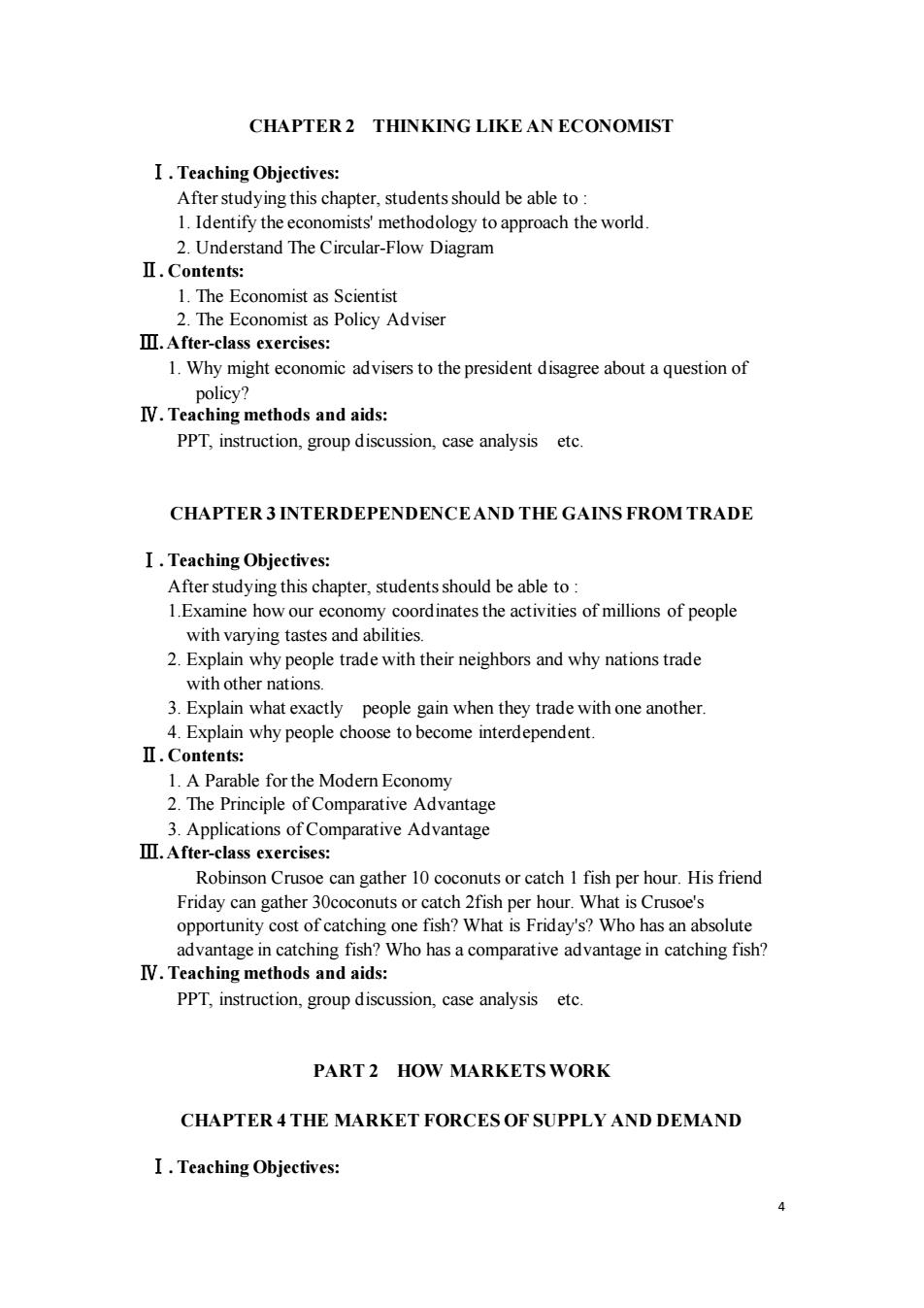正在加载图片...

CHAPTER2 THINKING LIKE AN ECONOMIST I.Teaching Objectives: After studying this chapter.students should be able to 1.Identify the economists'methodology to approach the world. 2.Understand The Circular-Flow Diagram Ⅱ.Contents: .The Economist as Scientist 2.The Economist as Policy Adviser I.After-class exercises: 1.Why might economic advisers to the president disagree about a question of IV.Teaching methods and aids: PPT,instruction,group discussion,case analysis etc CHAPTER 3INTERDEPENDENCEAND THE GAINS FROMTRADE I.Teaching Objectives After studying this chapter.students should be able to 1.Examine how our economy coordinates the activities of millions of people with varying tastes and abilities. 2.Explain why people trade with their neighbors and why nations trade 3.Explain what exactly people gain when they trade with one another 4.Explain why people choose to become interdependent. II.Contents: 1.A Parable for the Modemn Economy 2.The Principle of Compar ative Adva tage 3.Applications of Comparative Advantage II.After-class exereises: Robinson Crusoe can gather 10 coconuts or catch I fish per hour.His friend Friday can gather 30coconuts or catch 2fish per hour.What is Crusoe's tage in ching fish? Who has a comparative advantage in catching fish? PPT,instruction,group discussion,case analysis etc. PART2 HOW MARKETS WORK CHAPTER 4THE MARKET FORCESOF SUPPLY AND DEMAND I.Teaching Objectives: 4 CHAPTER 2 THINKING LIKE AN ECONOMIST Ⅰ. Teaching Objectives: After studying this chapter, students should be able to : 1. Identify the economists' methodology to approach the world. 2. Understand The Circular-Flow Diagram Ⅱ. Contents: 1. The Economist as Scientist 2. The Economist as Policy Adviser Ⅲ.After-class exercises: 1. Why might economic advisers to the president disagree about a question of policy? Ⅳ. Teaching methods and aids: PPT, instruction, group discussion, case analysis etc. CHAPTER 3 INTERDEPENDENCE AND THE GAINS FROM TRADE Ⅰ. Teaching Objectives: After studying this chapter, students should be able to : 1.Examine how our economy coordinates the activities of millions of people with varying tastes and abilities. 2. Explain why people trade with their neighbors and why nations trade with other nations. 3. Explain what exactly people gain when they trade with one another. 4. Explain why people choose to become interdependent. Ⅱ. Contents: 1. A Parable for the Modern Economy 2. The Principle of Comparative Advantage 3. Applications of Comparative Advantage Ⅲ.After-class exercises: Robinson Crusoe can gather 10 coconuts or catch 1 fish per hour. His friend Friday can gather 30coconuts or catch 2fish per hour. What is Crusoe's opportunity cost of catching one fish? What is Friday's? Who has an absolute advantage in catching fish? Who has a comparative advantage in catching fish? Ⅳ. Teaching methods and aids: PPT, instruction, group discussion, case analysis etc. PART 2 HOW MARKETS WORK CHAPTER 4 THE MARKET FORCES OF SUPPLY AND DEMAND Ⅰ. Teaching Objectives: